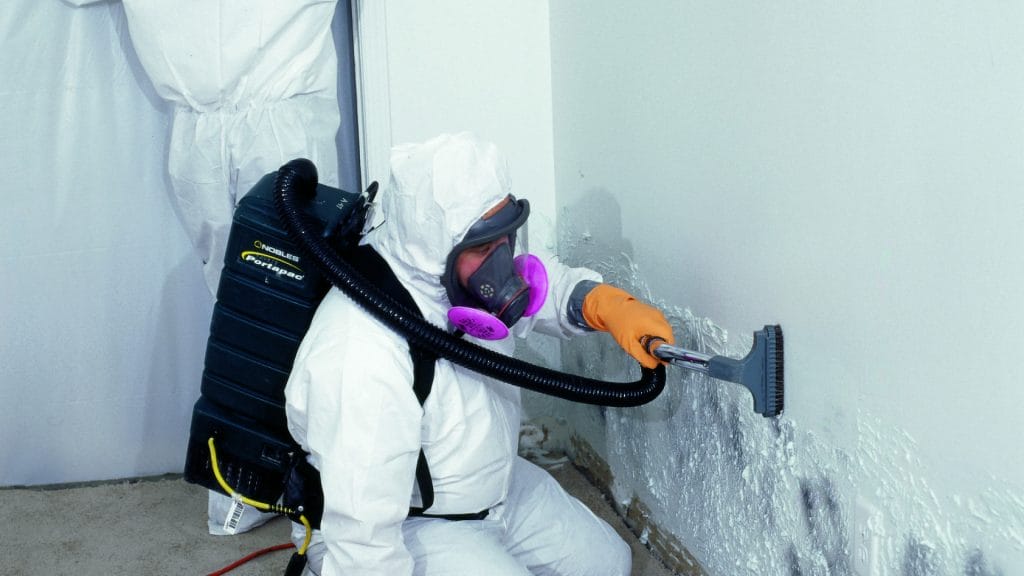What is Mold?
Mold is a type of fungi that grows in multicellular structures called hyphae. Mold spores are invisible to the naked eyes. Mold grows best in damp places, where they can begin to grow within 12-24 hours and become visible within 72 hours. There are thousands of different species of mold; some are used to produce common things like medicine (namely penicillin) and foods. However, when mold grows in your business property, it can be detrimental, causing property damage and health issues.
Mold growth in or around your property is dangerous because:
- When mold starts to grow, it feeds on the materials it is growing on, resulting in irreversible damage.
- Mold releases tiny spores and byproducts into the air, which can irritate or be the cause of many illnesses. If these are breathed in, they can cause respiratory problems. Stachybotrys Chartarum (Commonly known as black mold) is a common form of mold found in properties that can lead to such problems.
Mold Remediation Process
Mold remediation or mold removal is a complex process which involves much more than just simply spraying and wiping clean the affected surfaces.
BELFOR’s specialists will take the following stops to remediate mold:
- Fix Any Moisture Problems First If you suspect that your mold problem has been started by a leak or other water problem, it is important to fix this first because mold needs moisture to grow.
- Isolate Areas of Mold To avoid any cross-contamination, areas of mold must be isolated from other areas before demolition, cleaning or drying can begin.
- Throw Out Absorbent Materials Certain items that have been affected by mold, particularly porous items, will need to be removed completely.
- Clean Away The Mold All visible traces of mold will be removed before an antimicrobial or biocide spray is used to clean the surfaces during a wet wipe.
- Thoroughly Dry A thorough drying process is required to complete mold remediation. This will be accomplish using air movers and dehumidifiers, as well as moisture meters to provide an accurate reading as to whether the materials are dry.
Why do I need a Mold Removal Specialist?
At BELFOR, we specialize in the removal of mold from properties. BELFOR’s mold removal teams are considered the best in the industry and we were the first to issue mold guidelines in 2002. We were also the contributing authors to the official industry Reference Guide for Professional Mold Remediation
Large-scale mold removal requires expert knowledge and specialized equipment to carry out the mold remediation work. Certain situations require mold removal specialists to guarantee effective mold remediation, regardless of the size of the impacted area.
Proper Structural Drying
In order to reduce the chances of mold recurrence in your property, proper structural drying should take place. BELFOR provides commercial dehumidification and air purifying equipment and ensures that indoor air quality guidelines are followed. This type of large-scale work is particularly important after significant flooding or a large leak in the property. Simply cleaning away the mold without thoroughly drying the property will result in remaining moisture, leading to recurrence.
Flooding
Any mold that comes as a result of flooding should be removed by a professional mold removal expert. Flood water can be contaminated by sewage, chemicals and bacteria, and any contaminated water damage must be dealt with by an expert. Similarly, contaminated materials must be dealt with professionally as they pose serious health risks and can cause problems long after the flood.
Specialized Item Cleaning
Different items require different methods and approaches to cleaning and decontamination. Even if you have thoroughly wiped it and used a product described as a “mold removal spray”, there is still a chance that mold spores could remain within the fibers. Mold removal spray does not exist; mold must be removed professionally, and any spray will just form part of a wet wipe after.
Why do I need a Mold Removal Specialist?
Mold growth or settled spores can impact the HVAC system. This is because mold grows and travels through spores, when a HVAC system is contaminated with mold, the infestation can quickly spread and become a large-scale issue. Not only would the entire HVAC system need to be cleaned and decontaminated, but any of the spaces warmed or cooled by the air system would also need to be tested and potentially treated for mold due to possible exposure.
BELFOR offers a complete mold remediation process. This includes full structural drying and dehumidification, containment and decontamination as well as disposal of contaminated materials. We also recommend third-party air quality testing to ensure the property is safe with dangerous spores removed.
BELFOR understands the challenges you face.
A dedicated team that provides you with personalised and optimum support at all times.
